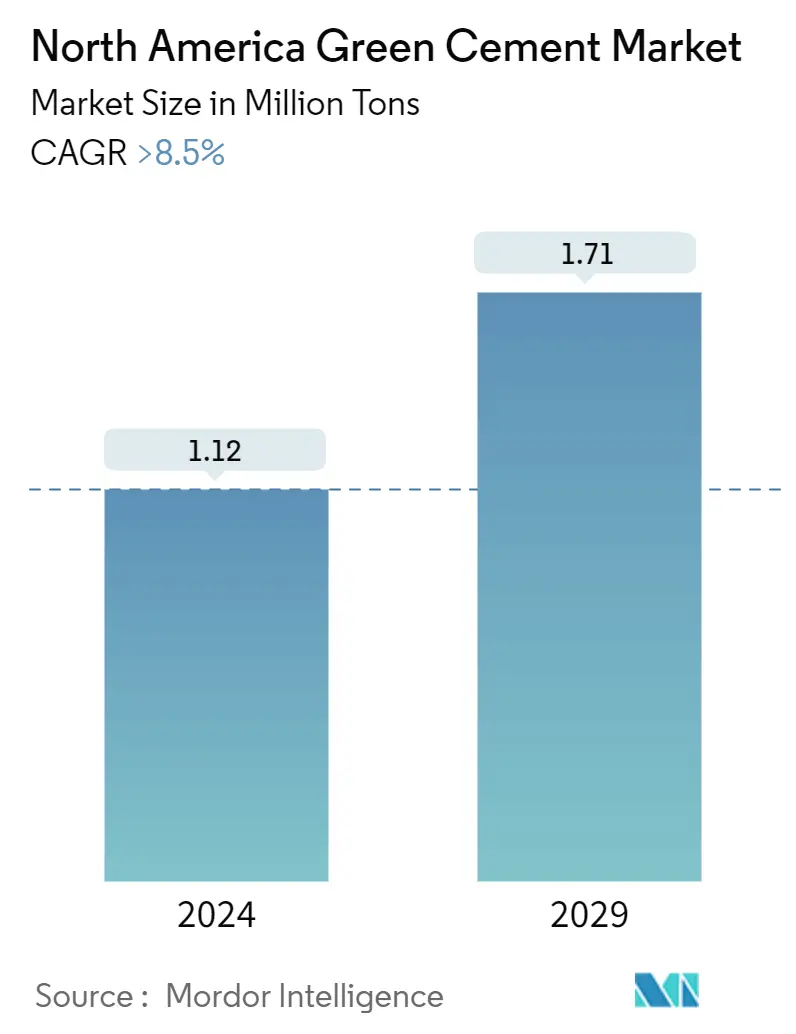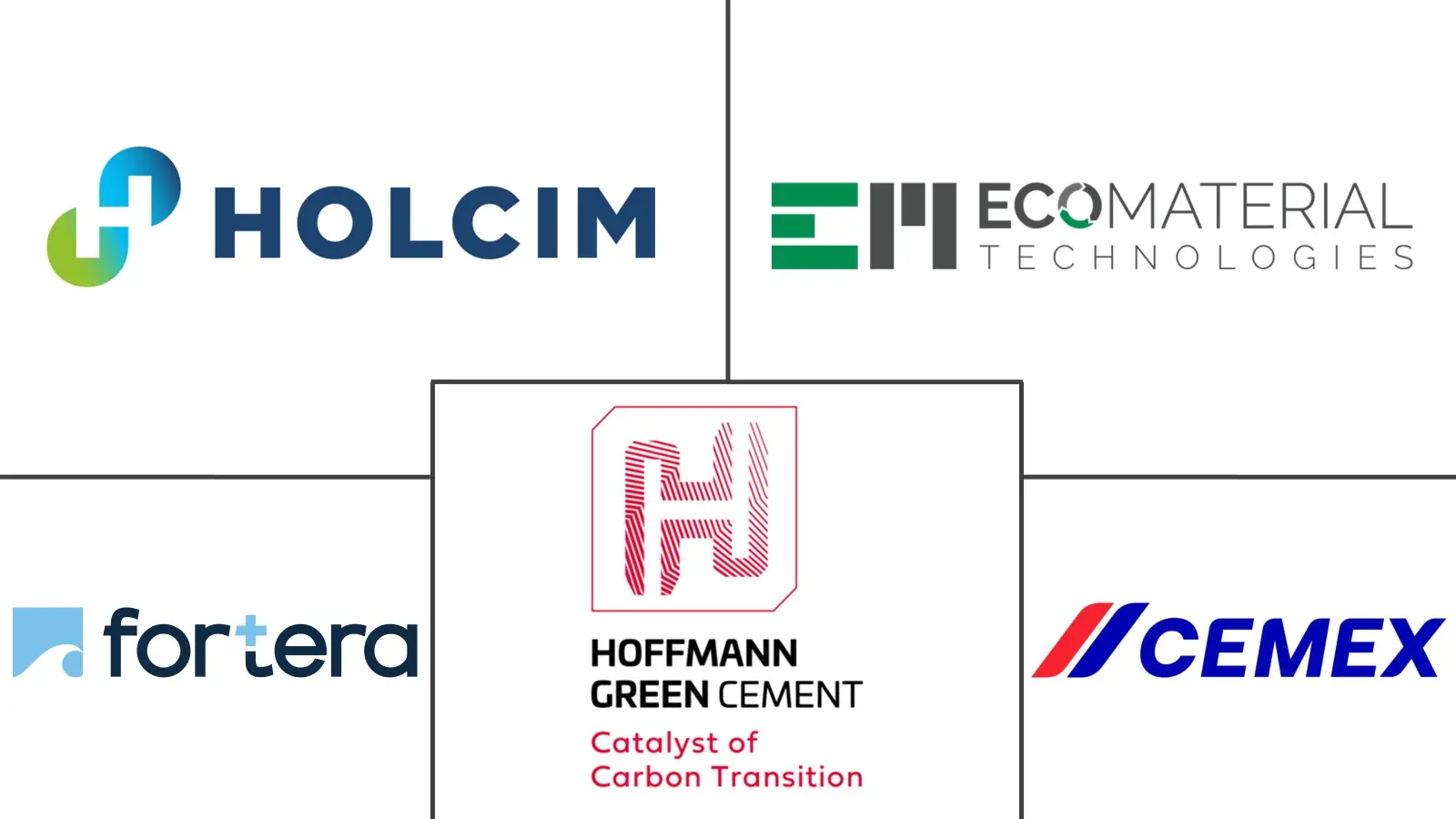Market Size of North America Green Cement Industry

| Study Period | 2019-2029 |
| Base Year For Estimation | 2023 |
| Forecast Data Period | 2024 - 2029 |
| Historical Data Period | 2019 - 2022 |
| CAGR (2024 - 2029) | 8.50 % |
| Market Concentration | High |
Major Players
*Disclaimer: Major Players sorted in no particular order |
North America Green Cement Market Analysis
The North America Green Cement Market size is estimated at 1.12 Million tons in 2024, and is expected to reach 1.71 Million tons by 2029, growing at a CAGR of greater than 8.5% during the forecast period (2024-2029).
The COVID-19 pandemic in 2020 had a significant impact on the North American green cement market, initially causing disruption and setbacks such as demand slump, production cuts, revenue losses, supply chain disruptions, and increased raw material prices, among others. However, with government initiatives against the pandemic, the situation started to get better and thus helped the market to recover and grow.
Over the short term, growing green construction projects, favorable government policies for the usage of green cement, and the availability of raw materials are major factors driving the growth of the market studied.
However, the rising cost of construction is likely to restrain the growth of the studied market.
Nevertheless, research and development of novel products as raw materials for green cement will likely create lucrative growth opportunities for the global market.
The United States represents the largest market for green cement in the region, and due to the increasing adoption of green cement in its construction projects, its dominance will likely increase over the forecast period.
North America Green Cement Industry Segmentation
Green cement is an environmentally friendly cement that reduces carbon dioxide emissions during manufacturing. Green cement is mostly produced from raw materials that are discarded as waste from industrial processes. Some of the major raw materials utilized in the production of green cement include the slag from the blast furnace and fly ash. Magnesium oxychloride cement, calcium sulfoaluminate cement, geopolymer cement, and sequestrated carbon cement are some examples of green cement.
North America's green cement market is segmented by product type, construction sector, and geography (United States, Canada, and Mexico). By product type, the market is segmented into fly ash-based, slag-based, limestone-based, silica fume-based, and other product types (geopolymers and recycled aggregates). By the construction sector, the market is segmented into residential and non-residential. The report also covers the market size and forecasts for the North American green cement market in 3 countries across the North American region.
For each segment, the market sizing and forecasts have been done on the basis of volume (tons).
| Product Type | |
| Fly Ash-based | |
| Slag-based | |
| Limestone-based | |
| Silica fume-based | |
| Other Product Types (Geopolymers and Recycled Aggregates) |
| Construction Sector | |
| Residential | |
| Non-residential |
| Geography | |
| United States | |
| Canada | |
| Mexico |
North America Green Cement Market Size Summary
The North American green cement market is poised for significant growth, driven by increasing adoption in construction projects across the region. The market is recovering from the disruptions caused by the COVID-19 pandemic, with government initiatives and favorable policies supporting its expansion. The United States leads the market, benefiting from substantial investments in climate solutions and a growing focus on sustainable construction practices. The demand for green cement is further bolstered by the rise of green building projects in Canada and Mexico, where eco-friendly construction materials are gaining traction. Despite challenges such as rising construction costs, the market is expected to thrive due to ongoing research and development in novel green cement products.
The construction industry in North America is experiencing steady growth, with both residential and non-residential sectors contributing to the increased demand for green cement. In the United States, significant investments in infrastructure and commercial projects are expected to drive market growth, while Canada and Mexico are witnessing a surge in green residential construction. The market is characterized by a partially consolidated landscape, with key players like Eco Material Technologies, HOLCIM, and Fortera Corporation leading the charge in innovation and expansion. These companies are actively pursuing strategies to enhance their production capabilities and reduce carbon emissions, aligning with the broader industry trend towards sustainability and environmental responsibility.
North America Green Cement Market Size - Table of Contents
-
1. MARKET DYNAMICS
-
1.1 Drivers
-
1.1.1 Growing Green Construction Activities in North America
-
1.1.2 Favorable Government Policies for Green Building Construction
-
1.1.3 Abundance of Availability of Raw Materials
-
-
1.2 Restraints
-
1.2.1 Rising Construction Costs
-
1.2.2 Other Restraints
-
-
1.3 Industry Value Chain Analysis
-
1.4 Porter's Five Forces Analysis
-
1.4.1 Bargaining Power of Suppliers
-
1.4.2 Bargaining Power of Buyers
-
1.4.3 Threat of New Entrants
-
1.4.4 Threat of Substitute Products and Services
-
1.4.5 Degree of Competition
-
-
-
2. MARKET SEGMENTATION (Market Size in Volume)
-
2.1 Product Type
-
2.1.1 Fly Ash-based
-
2.1.2 Slag-based
-
2.1.3 Limestone-based
-
2.1.4 Silica fume-based
-
2.1.5 Other Product Types (Geopolymers and Recycled Aggregates)
-
-
2.2 Construction Sector
-
2.2.1 Residential
-
2.2.2 Non-residential
-
-
2.3 Geography
-
2.3.1 United States
-
2.3.2 Canada
-
2.3.3 Mexico
-
-
North America Green Cement Market Size FAQs
How big is the North America Green Cement Market?
The North America Green Cement Market size is expected to reach 1.12 million tons in 2024 and grow at a CAGR of greater than 8.5% to reach 1.71 million tons by 2029.
What is the current North America Green Cement Market size?
In 2024, the North America Green Cement Market size is expected to reach 1.12 million tons.

